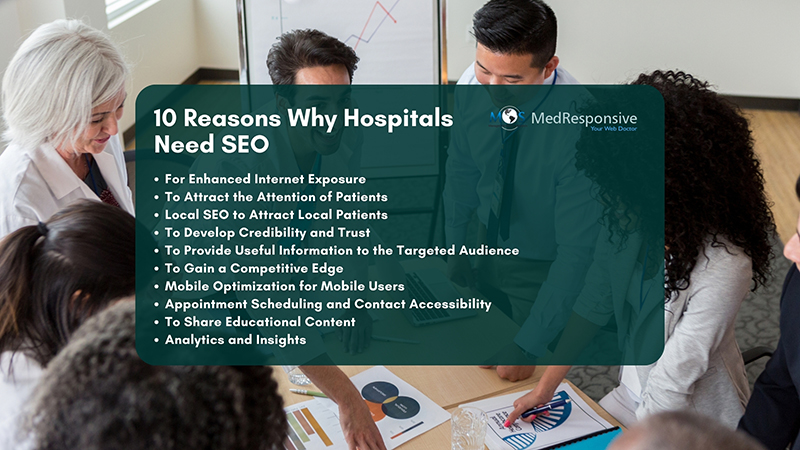Hospitals stand to gain a great deal from using SEO (search engine optimization) techniques. You can unlock the full potential of your hospital’s online presence by leveraging expert medical SEO services, ensuring increased visibility, patient engagement, and a competitive edge in the healthcare landscape. The term “hospital SEO” describes search engine optimization tactics created especially with hospitals and other healthcare facilities in mind. The process of optimizing a website for search engines like Google is known as search engine optimization, or SEO. When it comes to hospitals, it entails putting strategies into place to improve the hospital’s online visibility and website visibility in search engine results.
Reasons Why Hospitals Need SEO

Let us look at the need for implementing SEO for hospital websites and the strategies that are commonly used.
Enhanced Internet Exposure
By increasing online presence, hospitals can be found more easily by potential patients looking for pertinent medical services or information. Enhanced internet exposure can be achieved by using tactics to make online content more visible and accessible.
The following are instances of actions that can increase online visibility:
- Social Media Marketing Campaign
A hospital’s social media marketing campaign would focus on various aspects to engage and educate their targeted audience while showcasing their services and expertise. Typically, the platforms used are Facebook, Instagram, and Twitter. So, what are the main strategies they could use? Interesting infographics, short videos, or carousel posts such as those that share health tips are effective tactics. Other ways to enhance your social media presence are live Q & A sessions with healthcare professionals covering topics such as common health concerns, new medical advancements, general wellness advice and so on. What could be very interesting to the audience are inspiring stories of patients who have had successful surgeries/treatments at the hospital.
Behind-the-scenes glimpses can be shared on the social media platforms featuring the hospital staff, their expertise and dedication. Another interesting and effective strategy is to run health-related contests/challenges such as fitness challenges or healthy recipe contests which will surely engage audience participation and response.
- Use of Localized Keywords and Content
If your hospital is located in Chicago, you can optimize the content with keywords such as “top heart specialists in Chicago, or “leading cancer treatment center near downtown Chicago. When implementing local SEO services, you must use city-specific keywords in the website content, descriptions, headings, and meta titles. Location-specific landing pages and blog posts also help in enhancing local search visibility by placing the hospital’s address in prominent places on the website, such as content, meta descriptions, and titles. This informs search engines are informed by this optimization that the hospital is relevant for local searches.
Managing local citations-mentions of the hospital’s name, address, and phone number on various online platforms-should be a part of hospital’s SEO efforts. Having accurate and consistent citations on the internet helps to increase the visibility of local searches.
Hospitals need to produce content that is especially suited to the neighborhood. This could contain details about regional health issues, social gatherings, or medical projects. Enhancing content for local relevance brings you patients who are looking for local healthcare services.
- Content Marketing with Blogging
A hospital can keeps an active blog on which it posts pertinent, and educational and authoritative articles about its sector. By continuously creating excellent blog posts about common health concerns and by providing valuable insights. and making them search engine friendly, the business hospital can attract organic traffic and position itself as an authority in its industry.
- Google My Business Optimization
This is another important strategy to use. The hospital must ensure its Google My Business profile is complete with accurate information, including address, phone number, website, and operating hours. This Google My Business listing can be enhanced with relevant categories, high-resolution images, patient reviews, and timely updates. Encourage patients to leave positive reviews, as they can influence local search rankings.
- Implementing Schema Markup
This will provide search engines with specific information about the hospital’s services, operating hours, doctors, and various specialties. Moreover, it helps improve the chances of the hospital appearing in rich snippets such as featured snippets, knowledge panels and other search results.
- Link Building and Partnerships
This involves building high-quality back links from credible sources, which will help improve the hospital’s domain authority. Collaboration with local community groups or reputable medical organizations is important. It is also vital to regularly track website traffic, keyword rankings and user behavior using tools like Google Analytics and Google Search Console.
Developing Credibility and Trust
Establishing a solid online presence with the help of efficient SEO can help a hospital gain credibility and trust. A healthcare provider with a strong online presence has a higher chance of being chosen by patients. Hospital SEO makes sure that information is accurate and transparent on the hospital’s website. This information includes details regarding services, physicians, facilities, phone numbers, and business hours. Trustworthiness is influenced by accuracy and consistency across various online platforms.
Content creation for hospitals must be authoritative and educational. High-quality content enhances the hospital’s reputation as a reliable source of healthcare knowledge by addressing healthcare-related issues, offering insightful information, and showcasing medical field expertise.
Establishing credibility requires a website that is both aesthetically pleasing and easy to use. Optimizing a hospital website for a positive user experience entails making sure it is accessible, has clear calls to action, and is easy to navigate. An expertly designed website enhances the hospital’s reputation.
Online users are very concerned about security, particularly in the healthcare sector. The use of secure website protocols (HTTPS) to safeguard patient information is an important component of hospital SEO. Users are more likely to trust a website that is secure.
Adding timely and pertinent content to the website on a regular basis is part of hospital SEO. The hospital’s dedication to staying up-to-date and involved is demonstrated by its provision of information about new medical advancements, health advice, and community outreach initiatives.
Providing Useful Information
Content must be optimized for relevant keywords as part of SEO. This guarantees that a hospital’s website offers prospective patients useful and pertinent content that corresponds with their search terms. To find out exactly which terms and phrases prospective patients are using to look up healthcare information, extensive keyword research is necessary. Determine the pertinent medical conditions, therapies, and hospital-related services. Create a content mapping plan based on the keywords that have been identified. Make a plan that specifies the kind of content required for every topic or targeted keyword. This could include articles, FAQs, blog entries, and other informational materials.
Educate patients with informational materials that clarify medical conditions, available treatments, and preventive care. This kind of material presents the hospital as a reliable source of medical knowledge in addition to answering patient questions.
Make sure that each page’s meta title and description appropriately conveys its content. This would help increase click-through rates and aids search engines in determining how relevant the content is to users’ search queries.
Update the content with the most recent findings in medicine, technological developments, and modifications to healthcare procedures. Frequent updates reveal the hospital’s dedication to offering precise and pertinent information.
Make sure that people with disabilities can access the content. This entails utilizing readable fonts, offering alternative text for images, and making sure assistive technologies are compatible.
Throughout the content, use calls to action that are pertinent and unambiguous. Point users in the direction of the next action, such as making an appointment, getting in touch with the hospital, or using other resources. To make the healthcare experience more relatable, include success stories and patient testimonials. Positive testimonies from actual patients can reassure potential patients and foster trust.
Use interactive resources and tools, like calculators, virtual tours, and symptom checkers. These functions have the ability to captivate users and furnish them with insightful data in an interactive manner.
Gaining a Competitive Edge
SEO can give a competitive edge in the fiercely competitive healthcare sector. Investing in SEO increases the likelihood of hospitals ranking higher in search engine results than their rivals, attracting more potential patients.
Hospitals can target particular patient demographics and medical specialties by utilizing SEO strategies. They can focus on patients looking for particular medical services by tailoring their content to those patients’ demographics and relevant keywords.
Hospitals can showcase their specializations, strengths, and patient-centered philosophy through SEO. Through optimized content, the hospital can effectively communicate these differentiators and set itself apart in a crowded healthcare market.
Analyzing rivals and comparing against industry norms are key components of SEO. Hospitals can improve their SEO strategies and obtain a competitive advantage by analyzing the advantages and disadvantages of their rivals.
When it comes to patient acquisition, SEO can may be more affordable than traditional advertising techniques. Websites that are well-optimized draw organic traffic, which lowers the need for paid advertising and boosts the effectiveness of patient acquisition initiatives overall.
Keeping a positive online reputation and controlling online reviews are also important aspects of effective SEO. Good testimonials and reviews help establish credibility and trust, which gives the hospital an edge over competitors with unfavorable internet reviews.
Hospitals serving particular geographic areas need to prioritize local SEO. They can become the first choice for local patients by optimizing for local search terms, maintaining local citations, and interacting with the community online.
Mobile Optimization for Mobile Users
Hospitals must have a mobile-friendly website due to the growing popularity of mobile devices. In order to improve user experience for people accessing healthcare information on smartphones and tablets, SEO practices frequently involve mobile optimization. Hospital SEO places a strong emphasis on using responsive web design, which enables the website to adjust and function well on a range of screen sizes. The content is guaranteed to be readable and user-friendly on desktop and mobile devices thanks to a responsive design.
One of the key SEO strategies is to make content mobile-friendly. This entails producing content that is easily readable on smaller screens and is succinct. Clear headings, bullet points, and brief paragraphs improve the mobile user experience. Hospital SEO makes sure that, in order to reduce loading times, images are mobile-friendly. This improves the mobile website’s overall performance by using compressed images without sacrificing quality.
Page speed and mobile optimization go hand in hand. SEO tactics give priority to pages that load quickly because slow-loading pages can result in a bad user experience. On mobile devices, faster page loading can be achieved by maximizing HTTP requests, optimizing images, and utilizing browser caching.
The website’s navigation structure is taken into account by in SEO campaigns, especially for mobile users. Easy-to-access menus, simple buttons, and a logical hierarchy are all features of mobile-friendly navigation that improve the user experience on smaller screens. Optimizing website elements for touch interactions is part of SEO strategies. Forms should be designed so that they can be completed quickly and effectively on touchscreen devices, with buttons and links having enough size to be easily tapped.
Appointment Scheduling and Contact Accessibility
Hospital websites can be made more user-friendly with SEO by including features like online appointment scheduling and convenient contact information. Make sure the website prominently displays the hospital’s contact details, such as its phone number and email address. Any page should have easy access to this information, usually in the header or footer. Include a system for online appointment booking on the website. With the help of this feature, patients can easily make appointments via the website, cutting down on phone calls and expediting the scheduling procedure.
Add a click-to-call function for users of mobile devices. This makes it simple for users of mobile devices to call the number shown on the website to make an appointment or ask questions about services. Make a specific contact page with all the necessary details, including phone numbers, email addresses, and maybe a contact form. Make this page more search engine friendly so that relevant search results will show up for it.
Make use of structured data markup, like Schema.org, to give search engines your contact information, availability for appointments, and other pertinent details. This may improve these details’ visibility in search results. Make sure that all contact details are kept current, including phone numbers, email addresses, and office hours. Review and update this material frequently to prevent patients from becoming confused.
Ensure that the online forms are simple to use and easy to fill out if the hospital uses them to request appointments or answer general questions. To encourage submissions, maximize the form fields, give clear instructions, and reduce the number of fields that must be filled out.
Providing Educational Content
Making informative, high-quality content is a necessary part of SEO. Hospitals can establish their authority as reliable sources of health information by using SEO to distribute instructional content about illnesses, therapies, and preventive care. Highlight the medical staff and hospital’s experience in the content. Putting the credentials and experience of medical professionals’ front and center builds audience trust. Add citations and links to credible sources, like reputable medical websites, research papers, and journals. This gives the content more legitimacy and gives interested readers access to more resources.
Disseminate informative material on social media channels to expand your audience. Participation on social media can expand the content’s audience and promote community sharing. To assess how well instructional content is performing, use analytics tools. Keep an eye on metrics like time spent on page, social shares, and page views to find out what subjects interest people the most. Emphasize patient education when framing the information. Speak in plain English, stay away from medical jargon, and give patients insightful and useful advice to help them manage their health.
Determine the typical queries and concerns that patients might have regarding particular medical issues, therapies, or medical procedures. Provide information in your content that clearly and thoroughly answers these questions. Invite readers to share their stories, make comments, and pose questions. This encourages community involvement and gives the hospital the chance to respond to particular issues or concerns brought up by the viewers.
Analytics and Insights
Hospital SEO may help obtain important insights into patient behavior on the hospital website by utilizing a variety of analytics tools. These observations aid in comprehending how users engage with the website, what content interests them most, and how they move through the healthcare resources offered.
Link the hospital’s website to Google Analytics. Google Analytics offers extensive information on user behavior, including metrics for engagement, user demographics, and website traffic. Analyze how many pageviews each section of the website has. Determine which content and pages are well-liked and have a lot of interaction. Relevant content promotion and optimization are aided by this information.
Keep an eye on the bounce rate, which shows the proportion of visitors that leave the website after viewing only one page. It may be necessary to review the content and user experience of the website if a high bounce rate indicates that visitors are not finding what they need. Examine how long visitors spend on each page on average. A longer time on a page might mean that users are paying attention to the information, whereas a shorter time might mean that the calls to action or content need to be improved.
Configure Google Analytics to track particular user actions, like submitting forms, scheduling appointments, or downloading files. Conversion tracking offers information about how well calls-to-action and user interaction work.
Use event tracking for particular types of interactions, like clicking phone numbers, watching videos, or interacting with forms. This comprehensive data sheds light on user interactions that go beyond page views.
To see how users navigate the website, use the User Flow report in Google Analytics. To maximize user journeys, pinpoint frequent entry points, well-liked pages, and possible drop-off locations.
Sort user behavior data according to the channels and sources of traffic (direct, social media, organic search, etc.). The channels that are bringing the most engaged visitors to the website can be determined with the aid of this segmentation.
Analyze the effectiveness of landing pages, particularly those meant to direct visitors to particular resources or services. Determine which landing pages receive more interaction, then adjust the other pages in accordance with your findings. Determine which website pages are most frequently left empty by users. This data may point to possible problems or areas that those particular pages could use some improvement.
Consider Healthcare SEO Services for a Good Optimization Strategy
A well-structured SEO strategy can greatly improve a hospital’s online presence, attract new patients, and increase overall visibility and credibility in the digital landscape-even though word-of-mouth and traditional marketing are still important for healthcare facilities. When it comes to increasing online visibility and patient outreach, hospitals are recognizing the essential role of healthcare SEO services in navigating the digital landscape and ensuring their crucial healthcare information reaches those who need it most.
Ready to boost your hospital’s online presence and attract more patients?




